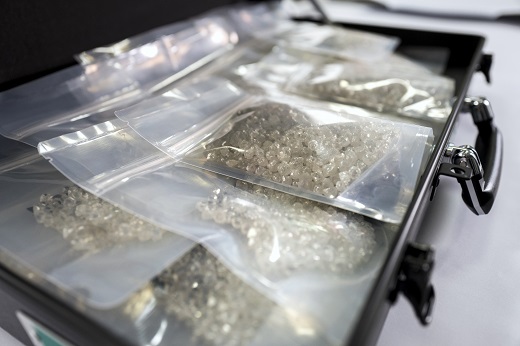De Beers Reduces Sightholder Supply
 RAPAPORT... De Beers sightholders are bracing for lower rough supplyfor the rest of 2019 as the miner reduces its production and fulfills itscommitments to support local manufacturing in Africa.The company expects production to drop as its Victor minein Canada closes and the Venetia operation in South Africa shifts from open-pitto underground mining. It has predicted output of 31 million to 33 millioncarats this year, compared with 35.3 million carats in 2018.A smaller quantity of rough diamonds will therefore be availableduring the new sales period starting next month comparedwith the current one, the miner confirmed. It informed sightholders of theirprovisional allocations ahead of last week's April sight, and will decide theirfinal allotments before the next sale begins on May 13.De Beers allocates rough diamonds based on clients'purchases in the previous intention-to-offer (ITO) period - a policy known as "demonstrated demand."Prospective sightholders tell De Beers how much rough they will require duringthe period - their "intention to offer" - with the miner subsequently informingthem how much they will receive.Last week's sight was the last of the current ITO period,which began a year ago. The new period will run from the May sight until theend of December, featuring only seven sights rather than the usual 10, as DeBeers is moving to a calendar-year ITO. Because of that shorter period, totalsupply will be lower, but it will also decline on a per-sight basis, said DavidJohnson, De Beers' senior manager for media and commercial communications.The lower supply is especially acute in larger diamondsizes, sightholders told Rapaport News.African commitmentsSeparately, the reduction will have a bigger impact oncompanies that take part in its core sales plan, known as the internationalsight. Customers with Botswana or Namibia sights - who buy rough formanufacturing in those countries - tend to be less affected when availabilitydrops, Johnson explained. That's because the miner's agreements withgovernments require the company to allocate certain quantities of goods to thoseclients, he continued.De Beers earmarks 15% of Botswana production for OkavangoDiamond Company, a state-owned seller of rough goods, and offers the remaining85% through Global Sightholder Sales (GSS), its contract-sales division. Itsells most of those GSS goods to international sightholders, but also commitsto offering an agreed dollar amount to Botswana sightholders for the benefit ofthe local cutting industry. The 2011 deal that governs those arrangements is upfor renewal next year.The miner operates a similar regime with the Namibiagovernment, with 15% of production going to state-owned trader Namdia, and additional goods becoming available to Namibia sightholders. That2016 deal prompted De Beers to reduce its supply to international sightholdersthe following year. "There's some uncertainty about how much rough we canget," a sightholder said. "This is a big dynamic. In the last year, it'ssuddenly coming to the forefront that more and more people who have factoriesin Botswana and Namibia will benefit."De Beers is due to release the sales total for the Aprilsight on Tuesday. Prices were stable compared with the previous sight, a brokerreported. Image: Rough-diamond parcels in a De Beers sight box. (De Beers)
RAPAPORT... De Beers sightholders are bracing for lower rough supplyfor the rest of 2019 as the miner reduces its production and fulfills itscommitments to support local manufacturing in Africa.The company expects production to drop as its Victor minein Canada closes and the Venetia operation in South Africa shifts from open-pitto underground mining. It has predicted output of 31 million to 33 millioncarats this year, compared with 35.3 million carats in 2018.A smaller quantity of rough diamonds will therefore be availableduring the new sales period starting next month comparedwith the current one, the miner confirmed. It informed sightholders of theirprovisional allocations ahead of last week's April sight, and will decide theirfinal allotments before the next sale begins on May 13.De Beers allocates rough diamonds based on clients'purchases in the previous intention-to-offer (ITO) period - a policy known as "demonstrated demand."Prospective sightholders tell De Beers how much rough they will require duringthe period - their "intention to offer" - with the miner subsequently informingthem how much they will receive.Last week's sight was the last of the current ITO period,which began a year ago. The new period will run from the May sight until theend of December, featuring only seven sights rather than the usual 10, as DeBeers is moving to a calendar-year ITO. Because of that shorter period, totalsupply will be lower, but it will also decline on a per-sight basis, said DavidJohnson, De Beers' senior manager for media and commercial communications.The lower supply is especially acute in larger diamondsizes, sightholders told Rapaport News.African commitmentsSeparately, the reduction will have a bigger impact oncompanies that take part in its core sales plan, known as the internationalsight. Customers with Botswana or Namibia sights - who buy rough formanufacturing in those countries - tend to be less affected when availabilitydrops, Johnson explained. That's because the miner's agreements withgovernments require the company to allocate certain quantities of goods to thoseclients, he continued.De Beers earmarks 15% of Botswana production for OkavangoDiamond Company, a state-owned seller of rough goods, and offers the remaining85% through Global Sightholder Sales (GSS), its contract-sales division. Itsells most of those GSS goods to international sightholders, but also commitsto offering an agreed dollar amount to Botswana sightholders for the benefit ofthe local cutting industry. The 2011 deal that governs those arrangements is upfor renewal next year.The miner operates a similar regime with the Namibiagovernment, with 15% of production going to state-owned trader Namdia, and additional goods becoming available to Namibia sightholders. That2016 deal prompted De Beers to reduce its supply to international sightholdersthe following year. "There's some uncertainty about how much rough we canget," a sightholder said. "This is a big dynamic. In the last year, it'ssuddenly coming to the forefront that more and more people who have factoriesin Botswana and Namibia will benefit."De Beers is due to release the sales total for the Aprilsight on Tuesday. Prices were stable compared with the previous sight, a brokerreported. Image: Rough-diamond parcels in a De Beers sight box. (De Beers)